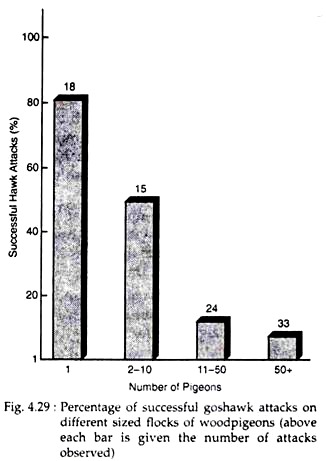The following points highlight the four ways by which prey escapes from the predator. The ways are: 1. Confusion of the Predator 2. Physical Defence 3. Mobbing 4. Geometrical Effects.
Way # 1. Confusion of the Predator:
Prey escape predation by confusing the predator. For example, a covey (small flock of bird) of bobwhite suddenly emerging out of a roost startles a fox and a hawk so much that it is unable to single out one of the birds to pursue.
In another case, a goshawk attacking large flocks of woodpigeons are confused so much that the flock becomes invulnerable to goshawk attack. However, when the goshawk attacks solitary woodpigeon, its success rate is very high (Fig. 4.29).
Way # 2. Physical Defense:
Some animals encounter predators through physical defense. For example, when muskoxen are attacked by wolves, the females gather the calves at the centre and form a circle around them. The adult males stay outside the circle to harass the wolves. Similarly, social insects like ant, termite etc., have soldier castes whose role is to defend the colony. They bite or stab the attackers or intruders or spray them with acid or glue.
Way # 3. Mobbing:
ADVERTISEMENTS:
In this category the prey attacks the predator in large crowd or group. The mobbing of horned owl by crows or of a leopard by baboons are a few examples.
Way # 4. Geometrical Effects:
The category of predator defense is, however, purely selfish. Hear each individual uses other individuals as cover. Thus, the ones at the middle of the flock or colony are the safest and the ones on the outer rim are the most vulnerable.
